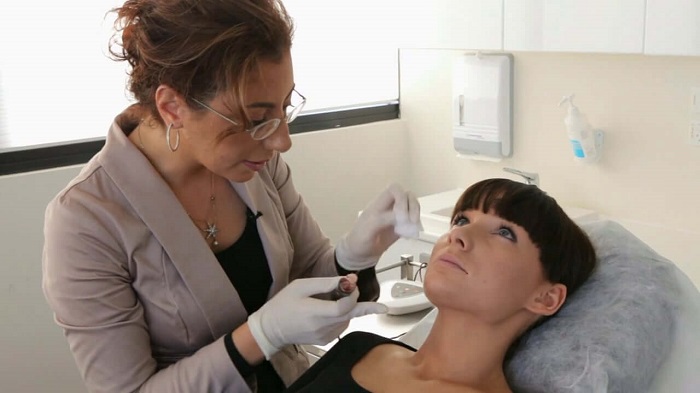Hyaluronic acid injections, also known as hyaluronic acid fillers, are among the most compatible with the human body. They are a popular choice for those who seek a temporary fix to the effects of aging, scarring, and other skin imperfections. Most plastic surgeons recommend them when a patient is not quite ready for a surgical facelift, or when the patient wants to delay the surgical procedure. Most patients will need 3 or more injections until they achieve the desired results, but this highly depends on each case in particular.
Although highly compatible with our skin and connective tissues, hyaluronic acid is far from being completely safe for our body. But before discussing the dangers and effects of this seemingly wonder treatment, let’s go through a few generalities about hyaluronic acid injections as a cosmetic treatment.

Some Basics of Hyaluronic Acid Injections
Hyaluronic acid injections can effectively treat a multitude of skin imperfections like:
- Wrinkles caused by toxic agents like smoking and other chemicals.
- Expression lines (glabellar lines, marionette lines around the mouth, worry lines on forehead, crow’s feet, or nasolabial lines).
- Multiple types of scars (including acne scars).
The good news about this procedure: it offers instant results and has no recovery time. The bad news: its effects are temporary.
What is Hyaluronic Acid?
Hyaluronic acid is a substance found in our skin tissue or in cartilages, joint fluid, other soft connective tissues, and neural tissues. The hyaluronic acid in our skin acts as a cushioning agent between the fibers of collagen and elastin. However, the passage of time, exposure to UVB rays, and other toxins in the air all reduce both the amount of hyaluronic acid in our skin, and its ability to function properly.
The substance comes as a gel and is lighter than other dermal fillers, which means they have lower risks, too. In addition, this makes them great for treating areas like the lips, forehead, cheeks, nasolabial folds, etc. However, this also means they are less effective than other more viscous materials like calcium hydroxylapatite.
How Do Hyaluronic Acid Injections Work?
Hyaluronic acid is a gel that acts as a cushion under our skin, supporting the structures that might have lost some of their elasticity, volume, or texture. This substance also helps water travel to the superficial layers of our skin and stay there, thus offering a supple and fresh look. But the most important function of this gel is its ability to transport nutrients from our bloodstream into the living skin cells, which further improves the aspect of the skin.

Contra-Indications of Hyaluronic Acid Injections
Because hyaluronic acid has an identical structure no matter how it was synthesized, these treatments don’t usually have contraindications. However, this doesn’t mean it’s completely safe. Women who are pregnant or breastfeeding should not undergo this procedure. In addition, the hyaluronic acid injection is not recommended for patients with skin conditions that increase scarring or irritation.
Those with inflamed or infected skin should wait until everything goes back to normal until undergoing this procedure. For patients with skin conditions like cysts, pimples, hives, or active inflammatory rashes, the procedure should take place only after the condition has been cured. Patients who suffer from blood coagulation disorders cannot, under any circumstances, undergo hyaluronic acid injections.
This treatment is not fit for extremely sensitive face areas like the eyelids since it will cause lumpiness and granuloma in most cases.
Hyaluronic Acid Injections Cost
The approximate cost of a hyaluronic acid injection is $600, but the pricing varies in terms of location, other included services, and the doctor himself. This average price does not include, however, other services like anesthesia, medication, prescriptions, or the surgical facility.
Such a treatment is usually needed after 4-12 months from the previous one, depending on each patient’s age and skin. If patients choose not to undergo the treatment again, the wrinkles, scars, and volume-less features will, in time, return.
How the Procedure Goes
A procedure lasts between 15 minutes and an hour. The doctor will start by thoroughly cleansing the area with a gentle alcohol-based cleaner. Then, he or she will apply a topical anesthetic to the areas where he or she will later inject the hyaluronic acid.

Now, on to the actual procedure. The doctor will take an extremely fine needle and inject the acid in one or more spots along the treatment area. After each 3-5 injections, the doctor will massage the area to evenly spread the gel under the skin.
Fine wrinkles and expression lines only require a superficial injection site, since they are mainly located in the epidermis. Deep wrinkles, on the other hand, can go deep enough to touch the fat layer under the skin, thus requiring a deeper injection site and greater care. In between these 2 we can find medium wrinkles, located within the dermis. After a while, if the effect of the topical anesthetic wears off, you might feel a light stinging sensation. This is normal, and easily fixable by asking the doctor to apply a bit more.
Even though you can see the effects as soon as the procedure is over, as the gel absorbs water molecules and holds them in, it will continue to increase in volume in the next few hours.
Effects of Hyaluronic Acid Injections
Just as mentioned before, hyaluronic acid injections for wrinkles or scars are not a permanent treatment. This means every few months, patients need to undergo the procedure again to enjoy the same results. This increases the skin’s sensitivity and reduces the expressivity of our facial features.

Expected Side Effects
Normal side effects that are part of the recovery process include mild redness and swelling, stinging, or bruising. Scabs can also appear, but they should go away within a few days and leave no traces behind. There’s no need to bandage the area, patients being able to go back to their daily routine as soon as they leave the clinic.
Abnormal Side Effects
The incidence of side effects after this procedure is about 5% overall.
The mere fact that doctors use a hypodermic needle to insert this substance into our skin can cause local nerve damage, rupture of blood vessels, pain, and bruising. Severe complications can include erythema, pruritus, and/or induration, granuloma, and even necrosis because of vascular occlusion. In extremely rare cases, vascular occlusion can lead to permanent blindness if the treatment was applied around the eyes. A small fraction of patients even experience delayed such symptoms, even 2 or 3 months after the injection.
Allergy to hyaluronic acid is uncommon, but extremely damaging when present. An allergic reaction to hyaluronic acid can lead to the appearance of some thickened red nodules at the injection site. These can go away after a few weeks or can last up to 9 months.
How to Choose a Reliable Professional

Although strict regulations dictate the use of hyaluronic acid in the U.S., you need to be selective regarding the clinic and the doctor you choose in order to reduce the risks of side effects.
- First of all, the medical professional you seek should be a specialist in dermatology or plastic surgery.
- Secondly, they should have experience in injecting dermal fillers under the face skin. This is particularly important since the face skin requires a shallower injection than other parts of the body.
- Be cautious about doctors who don’t inform you about the injection sites, your specific needs and procedure, the product brand they plan on using, and the risks of using hyaluronic acid.
- You should also discuss your expectations and how realistic they are with your medical professional.
Hyaluronic Acid Injections FAQs
Here are the most common questions about this procedure, together with their answers:
How to make sure my procedure will be risk-free?
Unfortunately, no procedure is 100% risk-free. However, you can drastically reduce the chances of experiencing side effects by choosing an experienced medical specialist who operates in a sterile environment and has thorough knowledge of the vascular anatomy. Other than that, a healthy diet and a decent amount of water also aid in staying healthy and away from complications after this procedure.

What brand should I choose?
Even though hyaluronic acid has the same chemical structure in every product and treatment, the excipients widely differ. But your doctor will ultimately decide which product is the best for your situation, depending on the issues you want fixed.
What if I’m not happy with the results?
Unfortunately, there’s not much you can do if the procedure did not go as you expected. You just have to wait for the effects to pass, if the damage is not permanent.
Note: This list is permanently expanded with the questions we receive from our users. If you feel like we didn’t cover a certain matter about hyaluronic acid injections, feel free to let us know in the comment section below.
All in all, hyaluronic acid injections are a reliable way of temporarily improving the aspect of the skin. But even though it’s a common procedure nowadays, it’s still not risk-free. From redness and swelling to necrosis and even permanent blindness, these treatments can sometimes do more harm than good.
